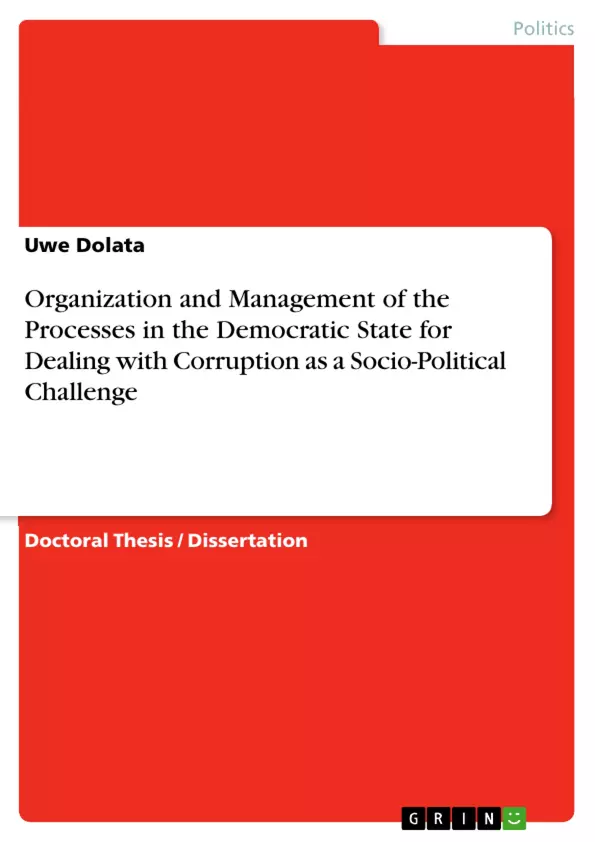The starting point for this study is the growing corruption in business and society worldwide. Swamp, felt and nepotism - more than every second EU citizen assumes that corruption, bribery and venality are the order of the day both in the EU and in their own country.
Therefore, the scientific study focuses on the sociological and criminological foundations of corruption and compliance as an administrative and corporate possibility for the prevention of corruption and white-collar crime.
In this context, the study considers compliance as a strategy and instrument that is intended to ensure correct behavior in accordance with applicable law. Nevertheless, the strategies and instruments also include moral-ethical codes of conduct, which are of course subject to voluntary action. The conditions, possibilities and limits of compliance measures are highlighted and political, legal and sociological design options are discussed.
Inhaltsverzeichnis (Table of Contents)
- INTRODUCTION.……………………..
- CHAPTER I. CORRUPTION AND COMPLIANCE..
- 1.1. Corruption in German companies
- 1.1.1. Definition: Corruption
- 1.1.2. Legal situation in Germany
- 1.1.3. The contractual relationship….......
- 1.1.4. Forms of corruption.......
- 1.1.5. Facts and figures......
- 1.1.5.1. Federal Situation Report Corruption...
- 1.1.5.2. Target areas of corruption ......
- 1.1.5.3. Suspects - distribution of donors and takers
- 1.1.6. The corruption dilemma.
- 1.1.7. Damage due to corruption ....
- 1.1.7.1. Distortion of competition .....
- 1.1.7.2. Damage to third parties and the perpetrator himself..\n
- 1.1.7.3. National economy, state and society as injured parties.......
- 1.1.8. Corruption paradox
- 1.1.9. Corruption in the middle class
- 1.2. Compliance in Germany.....
- 1.2.1. Definition and purpose of compliance .....
- 1.2.2. Medium-sized companies in Germany
- 1.2.3. Legal obligation to comply in Germany
- 1.2.3.1. Internationalization of the SME sector
- 1.2.3.2. Fraud.......
- 1.2.3.3. Competition offenses
- 1.2.3.4. Product liability.
- 1.2.3.5. Export regulations
- 1.2.3.6. Capital Market Law....
- 1.2.4. Objections to compliance....
- 1.2.5. Compliance in medium-sized businesses.
- 1.3. Corruption prevention - Compliance
- 1.3.1. Emergence of corruption and prevention through compliance.
- 1.3.1.1. The Fraud Triangle.
- 1.3.1.2. Compliance in three stages......
- 1.3.2. Corruption detection
- 1.3.3. Dealing with indications and acting on suspicions of corruption..........
- 1.3.3.1. Whistleblowing
- 1.3.3.2. Compliance Officer.
- 1.3.3.3. Ombudsmen
- 1.3.3.4. Summary hint systems
- 1.3.4. Code of Conduct......
- 1.3.5. Dual control principle and separation of functions ......
- 1.3.6. Staff rotation........
- 1.3.7. Minimum requirements of a compliance organization
- 1.3.8. Monitoring compliance programs.
- 1.3.8.1. State control.........
- 1.3.8.2. Control mechanisms.
- 1.3.1. Emergence of corruption and prevention through compliance.
- 1.4. Compliance - Implementation in medium-sized businesses....
- 1.4.1. Strategy...\n
- 1.4.2. Implementation in the organization and processes.
- 1.4.2.1. Compliance with commercial principles and transparency
- 1.4.2.2. Guidelines..........\n
- 1.4.2.3. Responsibilities
- 1.4.2.4. Employee training ....
- 1.4.2.5. Compliance management - risks and processes.\n
Zielsetzung und Themenschwerpunkte (Objectives and Key Themes)
This dissertation explores the sociological and criminological foundations of corruption and compliance as an administrative and corporate strategy for preventing corruption and white-collar crime. It focuses on the growing issue of corruption in business and society worldwide, emphasizing the need for effective compliance strategies to ensure ethical behavior. * **The sociological and criminological foundations of corruption:** The study delves into the roots of corruption and explores its various forms and consequences. * **Compliance as a strategy for corruption prevention:** It examines compliance as a strategic tool for fostering ethical behavior within organizations and preventing illegal activities. * **The legal framework for combating corruption:** The dissertation analyzes the legal landscape surrounding corruption, focusing on German regulations and international developments. * **The role of transparency in combatting corruption:** Transparency is identified as a crucial factor in preventing corruption and creating a culture of ethical conduct. * **The implementation of compliance strategies in medium-sized businesses:** The study explores practical approaches for implementing compliance measures in small and medium-sized enterprises (SMEs).Zusammenfassung der Kapitel (Chapter Summaries)
- **Introduction**: This chapter sets the stage for the dissertation by outlining the problem of corruption and its impact on societies worldwide. It emphasizes the need for effective countermeasures to combat this pervasive issue.
- **Chapter I: Corruption and Compliance**: This chapter delves into the multifaceted nature of corruption, analyzing its definition, legal framework, forms, and consequences. It examines the role of compliance in preventing corruption and discusses its implementation within German companies.
- **1.1. Corruption in German Companies**: This section focuses on the prevalence and impact of corruption in German companies, analyzing the legal situation, various forms of corruption, and their consequences on businesses, society, and the economy.
- **1.2. Compliance in Germany**: This section explores the definition, purpose, and legal obligation of compliance in Germany, highlighting its relevance for businesses and individuals. It also discusses the challenges and advantages of implementing compliance strategies in medium-sized companies.
- **1.3. Corruption Prevention - Compliance**: This section delves into the interplay between corruption and compliance, analyzing the emergence of corruption and the role of compliance measures in preventing it. It examines various methods for detecting and addressing corruption, including whistleblowing, compliance officers, and ombudsmen.
- **1.4. Compliance - Implementation in Medium-Sized Businesses**: This section provides practical insights into implementing compliance strategies in SMEs, exploring strategies, organizational adjustments, and key elements such as employee training and risk management.
Schlüsselwörter (Keywords)
The key concepts and themes of this study encompass the interconnectedness of corruption, compliance, and transparency. It examines the legal frameworks and strategies for combating corruption, particularly within the context of German businesses. It explores the challenges and opportunities associated with implementing compliance programs and addresses the crucial role of transparency in fostering ethical behavior and preventing corruption. Key terms include corruption, corruption prevention, compliance, non-compliance, transparency, legal framework, German companies, SMEs, risk management, and ethical behavior. - 1.1. Corruption in German companies
- Quote paper
- Uwe Dolata (Author), 2022, Organization and Management of the Processes in the Democratic State for Dealing with Corruption as a Socio-Political Challenge, Munich, GRIN Verlag, https://www.grin.com/document/1308388



